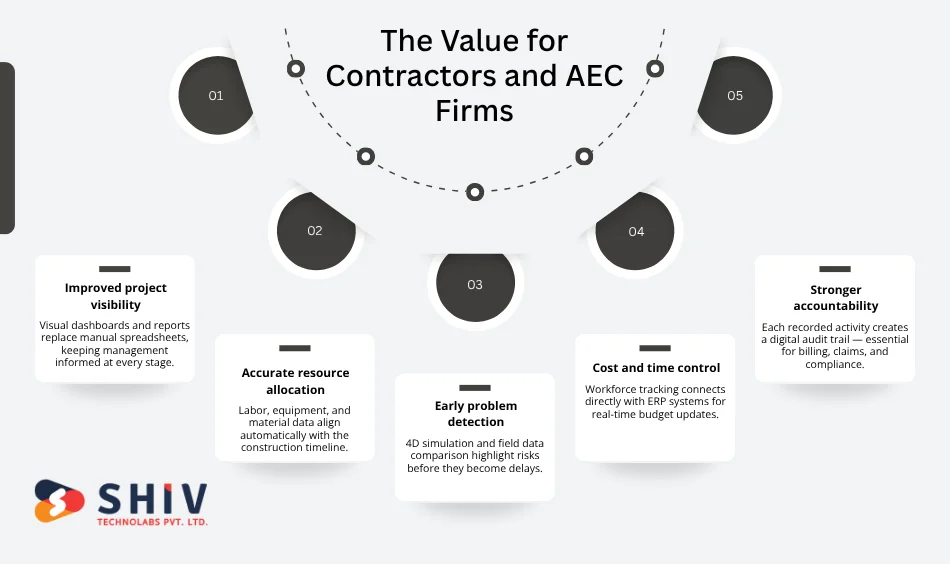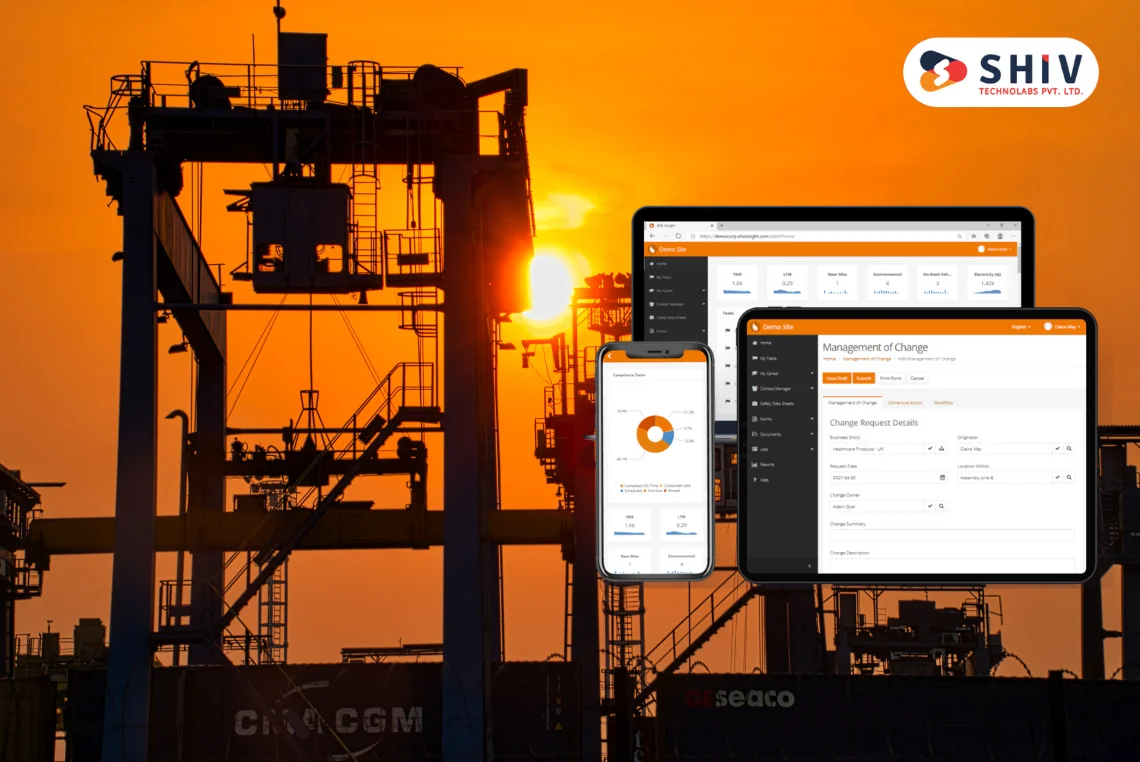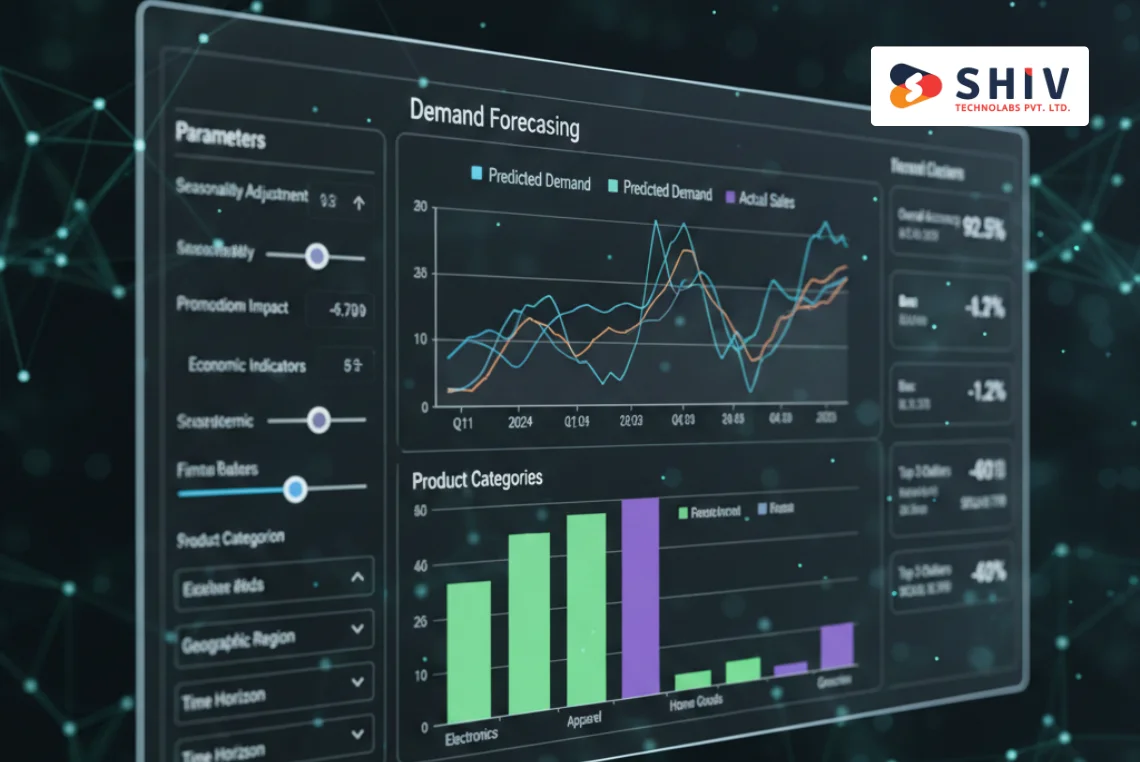Table of Contents
Construction projects run on tight deadlines, yet scheduling remains one of the biggest pain points for contractors. Many teams still manage timelines in spreadsheets while field data lives in emails, chat groups, or paper reports. The disconnect between office planning and on-site execution causes delays, idle resources, and repeated rework.
Modern construction companies are shifting toward digital scheduling software that links planning, execution, and reporting in one ecosystem. Two technologies lead this shift — 4D planning and crew tracking. Together, they align time, labor, and performance to keep every project on course.
When both features work under one digital platform, managers no longer depend on manual coordination. Schedules update automatically, progress becomes transparent, and everyone involved — from engineers to subcontractors — stays informed through real-time dashboards.
What Is 4D Planning — and Why It Matters?
Traditional 3D modeling helps visualize design, but it doesn’t explain how work will progress over time. 4D planning adds a time dimension to the model. It connects every construction activity to its corresponding timeline, showing how the project evolves day by day.
This process replaces static Gantt charts with dynamic visual schedules. Stakeholders can view the project sequence, detect overlaps, and predict clashes before work begins. A 4D plan makes communication easier because everyone can see when each task happens and how it affects the next phase.
Practical benefits of 4D planning include:
- Early detection of scheduling conflicts and resource shortages.
- Clear visualization of project milestones.
- Simplified coordination among architects, engineers, and contractors.
- Data-driven forecasting for deadlines and dependencies.
4D planning gives teams confidence that each stage of work aligns with the master schedule. It turns project planning from a guessing exercise into an evidence-based process.
How 4D Planning Works Inside Modern Construction Software?

Integrating 4D functionality within a construction project management platform makes scheduling accessible to everyone, not just BIM experts. The system links design data from tools such as Revit or Navisworks with a time-based task database. Each activity has a start and end date mapped to its 3D element.
When users run a simulation, they can watch the structure appear virtually — floors, walls, and systems assembling in sequence. This visual link between time and geometry helps identify bottlenecks before work starts on site.
Modern 4D scheduling modules also connect with procurement, equipment booking, and workforce planning. When material delivery or crew allocation changes, the timeline adjusts automatically. That’s how digital scheduling prevents surprise delays and improves control.
Crew Tracking: Turning Field Data into Scheduling Power
Even the most detailed 4D plan fails if crews don’t execute as scheduled. That’s where crew tracking systems come in. They capture live workforce data from the field and sync it directly with the main schedule.
Crew tracking apps record:
- Daily attendance and shift hours.
- Task assignments for each trade or team.
- GPS or QR-based location verification.
- Photos and notes for quality or safety reports.
Supervisors update everything through mobile devices, reducing paperwork and communication delays. The system then compares planned progress with actual on-site results. Managers instantly know if work is ahead or behind schedule.
This visibility helps project leaders act early — reallocating workers, approving overtime, or rescheduling follow-up tasks. It also improves accountability because every activity is traceable. Data collected across projects builds valuable insight for forecasting future labor needs and productivity benchmarks.
When 4D Planning and Crew Tracking Work Together?
4D planning shows what should happen. Crew tracking proves what did happen. When both systems operate in sync, scheduling becomes a real-time control loop instead of a monthly review process.
Imagine a dashboard where 4D visuals update automatically as crew data arrives from the field. The schedule highlights completed, ongoing, and delayed activities in color codes. If a critical task falls behind, alerts notify managers instantly. The next phase shifts accordingly, keeping the master plan accurate.
This closed-loop workflow allows:
- True “planned vs actual” comparison.
- Instant insight into delay impact.
- Fewer manual schedule revisions.
- Better collaboration between field teams and planners.
Such integrated construction scheduling software gives companies a single version of the truth. Everyone, from head office to job site, views the same timeline — current, verified, and actionable.
Read more: Trends in Digital Transformation in the Construction Industry
The Value for Contractors and AEC Firms

Modern contractors depend on speed and precision. Combining 4D scheduling and crew tracking delivers measurable advantages:
- Improved project visibility: Visual dashboards and reports replace manual spreadsheets, keeping management informed at every stage.
- Accurate resource allocation: Labor, equipment, and material data align automatically with the construction timeline.
- Early problem detection: 4D simulation and field data comparison highlight risks before they become delays.
- Cost and time control: Workforce tracking connects directly with ERP systems for real-time budget updates.
- Stronger accountability: Each recorded activity creates a digital audit trail — essential for billing, claims, and compliance.
These benefits turn scheduling into a strategic advantage rather than a recurring bottleneck. Companies gain better control, clients gain confidence, and project delivery becomes predictable.
Use Cases Across Construction Segments
The combined power of 4D and crew tracking applies across different project types:
- Commercial buildings: Coordinate multiple subcontractors and detect design-schedule conflicts early.
- Infrastructure projects: Manage distant sites with IoT-enabled tracking and live dashboards.
- Industrial plants: Monitor specialized teams and safety-critical operations in real time.
- Residential developments: Track progress across blocks, units, and finishing stages.
Each use case benefits from transparent scheduling that connects planners, supervisors, and clients. It replaces reactive firefighting with proactive management.
Building the Right Software Stack
Creating such connected construction systems requires strong integration between technologies. A typical architecture combines front-end visualization, mobile apps, cloud data storage, and analytics.
| Function | Technology Stack We Use | Business Outcome |
| 4D Scheduling & Simulation | BIM APIs, Revit, Navisworks, Unity, Three.js | Time-linked visualization of project phases |
| Crew Tracking | React Native, Flutter, GPS/QR APIs, Firebase | Real-time labor visibility and shift management |
| ERP Integration | Odoo, SAP, Microsoft Dynamics | Unified cost, resource, and timeline data |
| IoT Monitoring | MQTT, AWS IoT, Node.js | Equipment and safety data from the field |
| Analytics & Dashboards | Power BI, Tableau, Django, Python | Progress insights and variance reports |
Every construction firm’s workflow differs, so the software stack adapts accordingly. Some require cloud-based systems for multi-site projects, while others prefer on-premise integration with internal ERPs. The goal is consistent — a single digital environment for planning, tracking, and reporting.
How Construction Scheduling Software Delivers ROI?
Adopting advanced scheduling tools is not just about convenience — it delivers measurable returns. Research by industry analysts shows that digital project management systems reduce overall schedule overruns by up to 25% and cut manual reporting time by nearly 40%.
For medium-sized contractors, that translates into faster project turnover, reduced penalties, and better workforce utilization. For large developers, it improves coordination across multiple subcontractors and phases.
When time equals cost, having a reliable digital scheduling system directly influences profitability.
Future of Construction Scheduling
The future of construction scheduling moves toward predictive, AI-driven platforms. Systems will soon analyze historical data, weather patterns, and resource availability to predict schedule risks before they occur.
Key trends shaping the next decade include:
- AI-based delay prediction: Machine learning models flag likely slippages early.
- IoT integration: Sensors track equipment hours, environmental conditions, and worker safety.
- Digital twins: 4D models evolve into full virtual replicas for lifecycle management.
- Voice-driven updates: Field supervisors record progress through voice commands on mobile devices.
These technologies will help contractors move from reactive planning to predictive control. Schedules will adjust themselves based on data from the field, enabling near-real-time decision-making.
Why Construction Companies Choose Shiv Technolabs?
Construction technology demands a deep understanding of both software and site operations. Shiv Technolabs combines that expertise to deliver custom construction software solutions built around how real projects run.
Our dedicated teams specialize in:
- Integrating 4D BIM scheduling into custom ERP systems.
- Developing mobile crew tracking apps with GPS and photo reporting.
- Building IoT-connected dashboards for live site monitoring.
- Embedding AI analytics for productivity forecasting and cost variance.
Every platform is tailored — from intuitive dashboards for project managers to field apps for supervisors. We follow agile development so clients can test modules early and expand functionality as their needs grow.
Our experience covers residential, commercial, and infrastructure clients worldwide. Whether you need a centralized scheduling system or a field data application, our team
builds solutions that connect planning with real-world execution.
Conclusion
4D planning and crew tracking have become essential to modern construction scheduling. They bring together time, labor, and design in one connected digital environment.
By combining visual timelines with live field updates, contractors gain unmatched control over progress, resource use, and risk management. No more scattered files or delayed status reports — just accurate, up-to-date information driving every decision.
Partnering with Shiv Technolabs gives construction companies access to scalable software built specifically for their workflows. From 4D simulation to crew management and ERP integration, our digital solutions make construction scheduling faster, smarter, and easier to manage.
Building on data instead of assumptions is no longer optional — it’s the foundation of efficient construction.
FAQs
Q1. What is the main purpose of 4D planning in construction?
It links project activities with time and visuals, helping teams see how schedules align with actual progress.
Q2. How does crew tracking improve scheduling accuracy?
It records attendance, tasks, and productivity in real time, allowing planners to adjust schedules quickly.
Q3. Can 4D planning software connect with BIM models?
Yes, most modern scheduling tools integrate with BIM data for accurate visual sequencing.
Q4. Is 4D planning suitable for small contractors?
Yes, even small firms benefit by reducing coordination errors and visualizing daily progress.
Q5. What future trends will shape construction scheduling?
AI, IoT, and predictive analytics will soon drive dynamic rescheduling and progress forecasting.





















